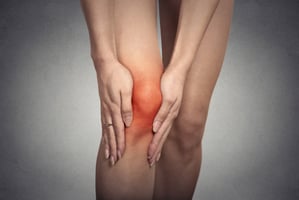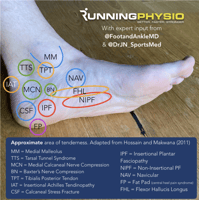Iliotibial Band (ITB) syndrome is the most common cause of outer knee pain in runners. Despite the...
Your Body is Your Greatest Investment
(Original Post Date: 3/22/23)
I think one of the best things to come out of the COVID times has been an overall greater emphasis on life satisfaction. I was a part of the “great resignation.” The time to reflect during the early days of covid helped me launch what is now a business helping hundreds of active people keep doing their favorite activities.
We love helping people who recognize how valuable participating in their activities is. There is no greater investment that we can make than choosing to invest in the longevity of our bodies.
The Benefits of Investing in Your Body
Choosing to keep your body in its best physical condition has numerous physical and mental health benefits.
The physical health benefits include:
- Reducing the risk of chronic diseases, such as:
- Heart disease
- Diabetes
- Cancer
- Chronic respiratory diseases
- Arthritis
- Obesity,
- Alzheimer’s Disease
- Hypertension
- Osteoporosis
- Improving cardiovascular health
- Boosting immune function
- Helping manage weight
- Improving bone density and strength
- Increasing muscle strength and endurance
- Enhancing flexibility and balance
The mental health benefits are numerous, including:
- Improving symptoms of depression
- Decreased likelihood of developing Alzheimer’s disease
- Better stress management, leading to improved relationships
- Improved overall mood
- Increased energy & productivity
- Increased self-esteem
- Improved confidence
- Increased feelings of empowerment which enable you to say yes to spontaneous adventures with friends or family
How to Invest in Your Body
There are 2 main areas where you can invest in your body: exercise & recovery.
Exercise
The exercise portion is simple. Generally, the more active you are the healthier you’ll be (assuming adequate recovery).
If you have any barriers that are preventing you from living as active a lifestyle as you’d like, these are potential areas that you can work on. Some common barriers include injuries and time.
If injuries are limiting your activity, do everything in your power to get the assistance you need to get over your injury as soon as you can, so you can then work on preventing any future injuries. If knee pain is limiting your running - proactively seeking help is choosing to invest in the longevity of your body. Ignoring the pain and hoping it’ll go away on its own can often lead to the issue becoming more chronic and lead you down potentially unnecessary costly interventions.
Another common limiter is time - which could be from a poor work-life balance, being busy with kids, or lacking the motivation to prioritize it.
Step 1 is determining the barrier.
Step 2 is finding the proper resources you need to help you break the barrier.
If your work is limiting your activity - consider a change to your job or hours to better allow for your desired level of fitness. If the weather prevents you from being more active - consider an investment in gear that allows you to remain active during the challenging weather times.
Recovery
Recovery tactics can be more complex. There are always new & exciting recovery tools & experiences - and we often get asked which things people should be trying.
Our general advice is simple: if you’re not already doing everything in your power to maximize your sleep quality & quantity, practice healthy eating habits, and practice stress-reducing techniques, then this is where your recovery focus should be. Everything else pales in comparison.
Sleep
Here are the first 3 tactics noted in the Huberman Lab’s Sleep Toolkit to improve your sleep quality & quantity. Check out all 12 tactics by reading the full toolkit.
- View sunlight by going outside within 30-60 minutes of waking. Do that again in the late afternoon, prior to sunset.
- Wake up at the same time each day and go to bed when you first start to feel sleepy.
- Avoid caffeine within 8-10 hours of bedtime.
Nutrition/Fueling
The term “healthy eating” can be a trap.
Of course you should be trying to eat a balance of food types & limiting processed foods. However what is often the most important concept for active people is that they are eating enough calories & protein.
Underfueling is a major contributor to overuse injuries such as stress fractures, as well as long term issues such as osteopenia & osteoporosis.
Stress-management
There are numerous stress-reducing techniques and what works well for one person may likely not work well for someone else. Living a life of no stress is not realistic. The key is that you have good ways to manage your stress. The ironic part is that a large part of this is often physical activity for many people - further emphasizing the importance of keeping your body injury-free.
Other common stress-management strategies include journaling, mindfulness, meditation, being active in nature, spending time with others or spending time alone.
For journaling I personally have been using the 1-1-1 method. Each night before bed I write out 1 win for the day to highlight a success, 1 tension/stressor from the day to get it out of my head and on paper, and 1 thing I am grateful for to put everything into perspective. On nights I journal I’ve been finding more deep sleep compared to the nights when I forget.
The Cost of Investing in Your Body
There is a tendency to think of the financial costs associated with gym memberships, physical therapy, healthy foods, and even the gear that allows you to participate in fun activities as luxuries. We challenge people to think of these costs differently - as an investment towards living the active, happy lifestyle that you want, that allows you to have great relationships with your family & friends.
When discussing costs we often find ourselves comparing our bodies to cars. When our car needs an oil change or a new part, we usually don’t question it. However, if your car breaks down you can get another one. We’re not given that luxury with the one body that we’re given…so why isn’t this outlook the standard for keeping our bodies in peak condition?
Making Your Body a Priority
The key to making your body a priority is setting achievable goals, celebrating progress and success, and avoiding getting too upset about the inevitable setbacks along the way. Having an accountability partner is always better than going at a goal alone.
If you’re interested in making your body your top priority, we should chat. We help people daily who are trying to push the limits of their body to live a more active lifestyle. Contact us at admin@steadystatehealth.com or click the button below to set up a free 20-minute discovery call to get started.




